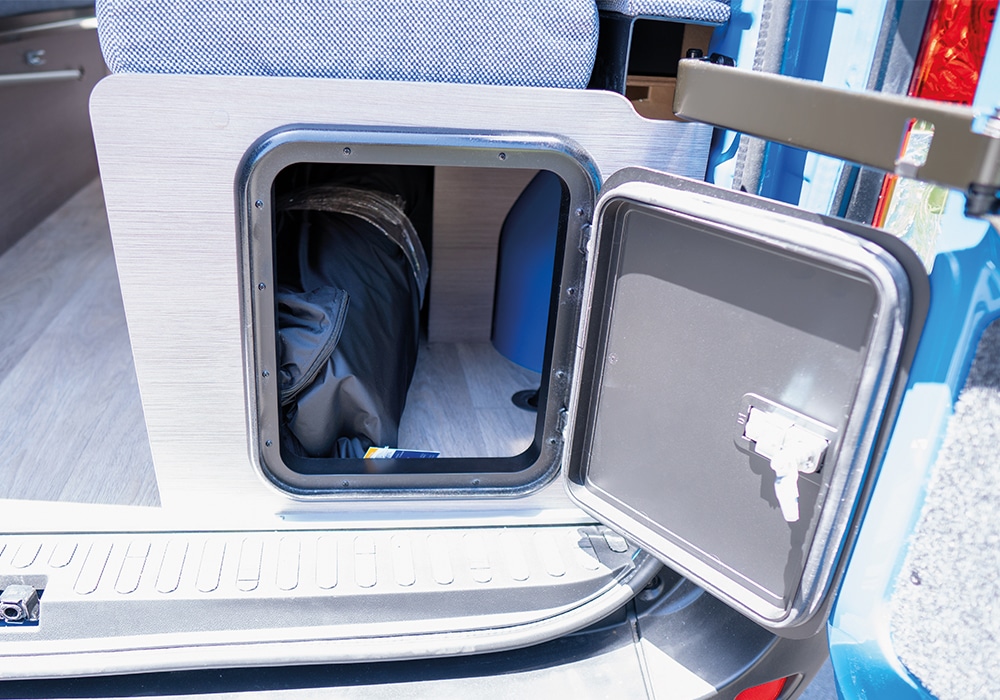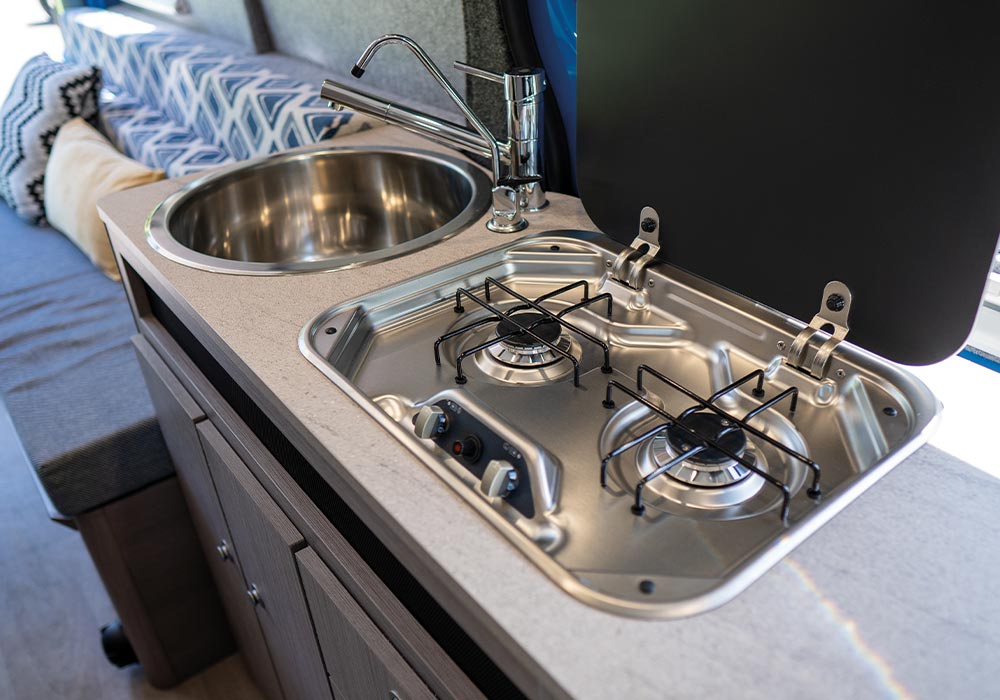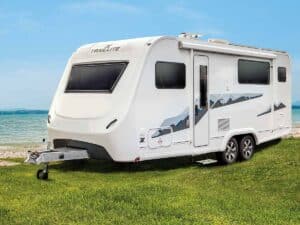Paul Owen investigates the advantages of choosing the Jayco RM.19-1, and finds a surprising amount of nifty tricks on board.
The advantages of a campervan over an admittedly more spacious motorhome or caravan are manyfold and this mode of RV travel remains a highly popular choice. That’s because the conversion of an ordinary commercial van into some form of mobile home often results in a vehicle that is more durable, safer, more compact, easier to drive and more economical to own and run.
However, there’s one further factor that probably seals the deal for campervan buyers. They’re generally more affordable than their motorhome brethren as the starting point is an existing van with its entire body remaining intact rather than one that’s been chopped up to have a more caravan-like body and extensive chassis and suspension modifications added. This is the reason that few new campervans of between 6-7m in length cost more than $200K, while that price point is increasingly becoming the place in the market where the pricing of new Class C semi-integrated motorhomes of more than 7m in length begins.

Most new campervans enter the New Zealand marketplace priced at around the $150K mark, while those from well-heeled European brands usually start at around $180,000, especially if furnished to impress. Apart from the cost of the conversion of a commercial vehicle into a campervan and the quality of its furnishing, the biggest factor influencing campervan prices is the cost of the van that forms the starting point. For example, Volkswagen’s popular (and now sold out for a year) New Zealand campers, the Grand California 600 and 680, use 4WD versions of the Crafter van range that cost over $100,000 when simple delivery vans. Hence the 6m-long 600 costs $169,000 while the 6.8m-long 680 lists for $173,000, once all the insulation, plumbing, electrics, appliances, solar system, extra battery, beds, tanks, storage, and furniture has been added.
But what happens if the RV manufacturer chooses a delivery van that costs $67,990 in New Zealand as its blank campervan canvas? Enter the $118,990 Jayco RM.19-1, one of the most affordable campervans available as it’s based on the long wheelbase version of the Renault Master van. If you want any colour other than white for your RM.19-1, it’ll add another $1000 to the price. Based on this eye-catching Caribbean Blue example that extra grand is worth paying. Other added-cost colour choices include Urban Grey and Orange.

Affordable and affable
The Master does command a few extra tricks these days, like the sidewind steering assistance that kicks in at speeds above 70km/h, the cruise control, reversing camera, and the 7” touchscreen located at the top-dead-centre of the dashboard that offers satellite navigation and cellphone projection via Apple CarPlay and Android Auto. However, in a couple ways, this is yesteryear’s van.
Emission control is at Euro 5 level for Master models destined for Tasman Sea markets, meaning that the Renault’s contribution of the toxic oxides of nitrogen that cause acid rain and damage human lungs is over twice that of rival diesel vans that meet the far cleaner Euro 6 standard. Which happens to also be the standard that the Renault Master has been meeting since 2019… in Europe.
Although it’s a pity that the RM.19-1 doesn’t currently come with the European model’s exhaust system, complete with the AdBlue injection that turns a high percentage of the nasty nitrous oxides into harmless water vapour, the trueblue Aussie does have a part to play in the reduction of toxic emissions via its accessibility. If the van’s sector-leading affordability encourages you to trade up from your present Euro 3 or Euro 4 rated RV, you’re making a meaningful vehicle swap towards enabling better air quality.
As France’s largest automotive corporation, Renault is very Franco-focused and most van drivers there prefer to drive with three pedals. Which means that a new two-pedal driveline for the Master isn’t a priority, so the van soldiers on with an automated six-speed manual gearbox that is a little jerky on takeoff and shunts lazily through the upshifts when compared with conventional automatic transmissions. If buying a RM.19-1, I’d feel tempted to ask if the six-speed manual gearbox used and loved by a vast majority of Master drivers in Europe is available to special order. Manual Masters also generate more power.
Phew, glad those two things are out of the way, because the rest of the Master is rather good. The 2.3L turbodiesel driving the front wheels has the grunt and refinement to shift the unladen 2750kg mass of the RM smoothly and effortlessly, producing peaks of 110kW of power and 350Nm of force. A positive of the auto-manual six-speed is that it’s pretty good at conserving fuel, and back when the Master was simply a delivery van it recorded 9.5litres/100km average fuel use when tested to Australian Design Rule standard.

Also helping that fuel conservation is the low weight of the unladen RM, helped by a side door and double rear doors that are relieved of the excessive weight of full insulation. The latter isn’t really an issue as there’s a highly effective Espacher diesel heater to keep the cabin cosy in winter, and said doors provide plenty of cooling air flow if kept open in summer. Compared with the portals of other campervans, they’re so effortless to open and close.
To that unladen mass, Jayco adds a generous payload of 760kg, blowing out the Gross Vehicle Mass to 3510kg, ten kilograms above the threshold where more frequent CoF checks are required instead of less regular WoF testing. This sidesteps the $3623 clean car fee that the first owner of the JRV would have paid upon initial registration. It’s a short-term saving that complicates the ownership experience and may affect the resale appeal of the RM when it comes time to sell it on. On the plus side, that ability to cart extra mass also means that even when utilising the maximum permissible towball weight of 200kg, there’ll still be 560kg of payload left in reserve. Sumo wrestlers with a penchant for carrying training weights while on tour, your ideal two berth, two passenger campervan has arrived.
Cab-free cabin
When driving the 6.2m long RM, there is a clear line of sight from the rear-view mirror to the windows of the rear doors, a boon to visibility and recon-derived intel of what’s behind. When parked for the night, the cab is best used as a handy storage area for surplus luggage as the seats can’t be swiveled around. There are some suction cup-mounted temporary curtains to screen the cab windows at night, but if the RM was mine, I’d mount a permanent curtain rail behind the cab for a neater and more easily screened cabin.

Tinted windows are an option that’s worth ticking on the RM as the rear door windows appear to have no curtains. The cabin floor is located 200mm below the cab floor, resulting in a generous floor to ceiling measurement of 1.88cm inside the RM. For a campervan that has had no roof modifications that’s impressive. It adds to a general feeling of airiness inside along with the compact kitchen, the rear lounge with its trooper-style bench seating, and the way the washroom is tucked so neatly into the driver’s side front corner of the cabin that you hardly notice it at first glance.
From there, you’re immediately drawn to the rear of the RM, encouraged by the natural light entering the cabin via the window on either side of the lounge and the rear door windows. The rear doors have two open positions, one at 90 degrees and the other at 270 (the latter provided no bike rack has been fitted), and they create what a real estate agent would call ‘good indoor/outdoor flow’.
There are plenty of cupboards located above the lounge area and lifting the squabs of the rear benches accesses more storage underneath. The passenger side bench has some of that stowage poached by the diesel heater and its delivery ducts, but on the other side longer items can be stored. Both have access doors at the rear that can be opened once the rear doors have been opened.

There are two options for converting the lounge into sleeping quarters. It can either provide two single beds measuring 640mm wide and 1730mm long on the driver’s side, and 1900mm long on the passenger side. Or the single leg table can be dropped to be used as a part of a base for a double bed, created by using one of the lounge backrests to fill the gap between the two single mattresses.
Full facilities
The difference in the length of the single beds is due to the mounting of the 65L fridge/freezer on the driver’s side of the cabin. This sits on top of a cupboard containing the Nautilus gas powered water heater, which provides continuous hot water on demand. Above the fridge is the microwave oven, while on the side of the fridge cabinet is the 24” LED smart TV located on a flexible mount.

Opposite the fridge is a sink that’s larger than the average campervan’s, located next to a two-burner gas hob. There isn’t a lot of bench space for preparation, but the lounge table is handily placed nearby. Like the kitchen, the washroom is compact, and there’s a small Camec basin tucked into a corner to create more elbow space when showering. The flush toilet is the usual swiveling bowl facility used in most campervans, with a 10L catch tank.
Going Native
The RM.19-1 is fully-equipped for a night or two of freedom camping, perhaps more if you can conserve water use, as it comes with a 60L freshwater tank and a 45L greywater reservoir. There’s a 200W solar panel to keep the modestly-sized fridge operating along with the 100Ah domestic battery. The 4kg gas bottle is light and easy to swap out but its size does shorten the time that the Jayco can stay parked in a single place along with the limited water supply and holding tank capacity.

Not that any of this really matters, because the accessible price of the Renault Master-based RM.19-1 absolves the Jayco of every perceived shortcoming. If you really need more, Jayco also offers a Fiat Ducato-based RM.19-1 – but you will have to pay quite a bit more for it.

| SPECIFICATIONS | |
|---|---|
| MAKE & MODEL: | JAYCO RM.19-1 |
| CHASSIS: | Renault Master long wheelbase van, front wheel drive |
| ENGINE: | 2.3 litre turbo-diesel, 110kW |
| GEARBOX: | Six-speed automated manual |
| BERTHS: | 2 |
| LENGTH/WIDTH/HEIGHT: | 6200mm/2150mm/2770mm |
| FRESH/GREY WATER: | Fresh 60L/Grey 45L |
| GVM/PAYLOAD: | 3510kg/760kg |
| UNLADEN MASS (TARE): | 2750kg |
| PRICE: | $118,990 |

For more information, visit https://www.jayco.co.nz/








